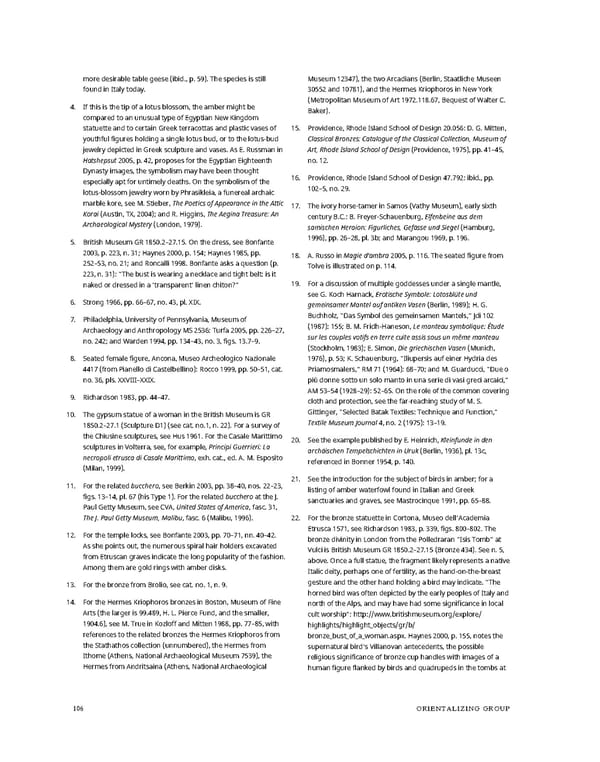more desirable table geese (ibid., p. 59). The species is still Museum 12347), the two Arcadians (Berlin, Staatliche Museen found in Italy today. 30552 and 10781), and the Hermes Kriophoros in New York 4. If this is the tip of a lotus blossom, the amber might be (Metropolitan Museum of Art 1972.118.67, Bequest of Walter C. compared to an unusual type of Egyptian New Kingdom Baker). statuette and to certain Greek terracottas and plastic vases of 15. Providence, Rhode Island School of Design 20.056: D. G. Mitten, youthful figures holding a single lotus bud, or to the lotus-bud Classical Bronzes: Catalogue of the Classical Collection, Museum of jewelry depicted in Greek sculpture and vases. As E. Russman in Art, Rhode Island School of Design (Providence, 1975), pp. 41–45, Hatshepsut 2005, p. 42, proposes for the Egyptian Eighteenth no. 12. Dynasty images, the symbolism may have been thought 16. Providence, Rhode Island School of Design 47.792: ibid., pp. especially apt for untimely deaths. On the symbolism of the 102–5, no. 29. lotus-blossom jewelry worn by Phrasikleia, a funereal archaic marble kore, see M. Stieber, The Poetics of Appearance in the Attic 17. The ivory horse-tamer in Samos (Vathy Museum), early sixth Korai (Austin, TX, 2004); and R. Higgins, The Aegina Treasure: An century B.C.: B. Freyer-Schauenburg, Elfenbeine aus dem Archaeological Mystery (London, 1979). samischen Heraion: Figurliches, Gefässe und Siegel (Hamburg, 5. British Museum GR 1850.2–27.15. On the dress, see Bonfante 1996), pp. 26–28, pl. 3b; and Marangou 1969, p. 196. 2003, p. 223, n. 31; Haynes 2000, p. 154; Haynes 1985, pp. 18. A. Russo in Magie d’ambra 2005, p. 116. The seated figure from 252–53, no. 21; and Roncalli 1998. Bonfante asks a question (p. Tolve is illustrated on p. 114. 223, n. 31): “The bust is wearing a necklace and tight belt: is it naked or dressed in a ‘transparent’ linen chiton?” 19. For a discussion of multiple goddesses under a single mantle, see G. Koch Harnack, Erotische Symbole: Lotosblüte und 6. Strong 1966, pp. 66–67, no. 43, pl. XIX. gemeinsamer Mantel auf antiken Vasen (Berlin, 1989); H. G. 7. Philadelphia, University of Pennsylvania, Museum of Buchholz, “Das Symbol des gemeinsamen Mantels,” Jdi 102 Archaeology and Anthropology MS 2536: Turfa 2005, pp. 226–27, (1987): 155; B. M. Fridh-Haneson, Le manteau symbolique: Étude no. 242; and Warden 1994, pp. 134–43, no. 3, figs. 13.7–9. sur les couples votifs en terre cuite assis sous un même manteau (Stockholm, 1983); E. Simon, Die griechischen Vasen (Munich, 8. Seated female figure, Ancona, Museo Archeologico Nazionale 1976), p. 53; K. Schauenburg, “Iliupersis auf einer Hydria des 4417 (from Pianello di Castelbellino): Rocco 1999, pp. 50–51, cat. Priamosmalers,” RM71 (1964): 68–70; and M. Guarducci, “Due o no. 36, pls. XXVIII–XXIX. più donne sotto un solo manto in una serie di vasi greci arcaici,” 9. Richardson 1983, pp. 44–47. AM53–54 (1928–29): 52–65. On the role of the common covering cloth and protection, see the far-reaching study of M. S. 10. The gypsum statue of a woman in the British Museum is GR Gittinger, “Selected Batak Textiles: Technique and Function,” 1850.2–27.1 (Sculpture D1) (see cat. no.1, n. 22). For a survey of Textile Museum Journal 4, no. 2 (1975): 13–19. the Chiusine sculptures, see Hus 1961. For the Casale Marittimo 20. See the example published by E. Heinrich, Kleinfunde in den sculptures in Volterra, see, for example, Principi Guerrieri: La archäischen Tempelschichten in Uruk (Berlin, 1936), pl. 13c, necropoli etrusca di Casale Marittimo, exh. cat., ed. A. M. Esposito referenced in Bonner 1954, p. 140. (Milan, 1999). 11. For the related bucchero, see Berkin 2003, pp. 38–40, nos. 22–23, 21. See the introduction for the subject of birds in amber; for a figs. 13–14, pl. 67 (his Type 1). For the related bucchero at the J. listing of amber waterfowl found in Italian and Greek Paul Getty Museum, see CVA, United States of America, fasc. 31, sanctuaries and graves, see Mastrocinque 1991, pp. 65–88. The J. Paul Getty Museum, Malibu, fasc. 6 (Malibu, 1996). 22. For the bronze statuette in Cortona, Museo dell’Academia 12. For the temple locks, see Bonfante 2003, pp. 70–71, nn. 40–42. Etrusca 1571, see Richardson 1983, p. 339, figs. 800–802. The As she points out, the numerous spiral hair holders excavated bronze divinity in London from the Polledraran “Isis Tomb” at from Etruscan graves indicate the long popularity of the fashion. Vulci is British Museum GR 1850.2–27.15 (Bronze 434). See n. 5, Among them are gold rings with amber disks. above. Once a full statue, the fragment likely represents a native Italic deity, perhaps one of fertility, as the hand-on-the-breast 13. For the bronze from Brolio, see cat. no. 1, n. 9. gesture and the other hand holding a bird may indicate. “The horned bird was often depicted by the early peoples of Italy and 14. For the Hermes Kriophoros bronzes in Boston, Museum of Fine north of the Alps, and may have had some significance in local Arts (the larger is 99.489, H. L. Pierce Fund, and the smaller, cult worship”: http://www.britishmuseum.org/explore/ 1904.6), see M. True in Kozloff and Mitten 1988, pp. 77–85, with highlights/highlight_objects/gr/b/ references to the related bronzes the Hermes Kriophoros from bronze_bust_of_a_woman.aspx.Haynes 2000, p. 155, notes the the Stathathos collection (unnumbered), the Hermes from supernatural bird’s Villanovan antecedents, the possible Ithome (Athens, National Archaeological Museum 7539), the religious significance of bronze cup handles with images of a Hermes from Andritsaina (Athens, National Archaeological human figure flanked by birds and quadrupeds in the tombs at 106 ORIENTALIZING GROUP
 Ancient Carved Ambers in the J. Paul Getty Museum Page 115 Page 117
Ancient Carved Ambers in the J. Paul Getty Museum Page 115 Page 117